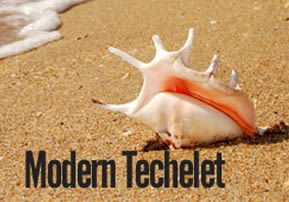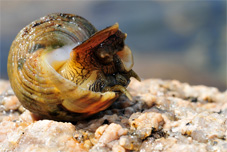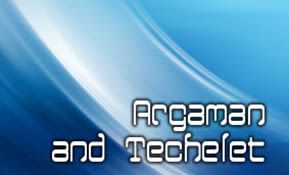
Modern Techelet
There is a tradition from Rebbe Nachman of Breslev that right before Mashiach comes, the mitzvah of the techelet in tzitzit will be reinstated...

Biblical Blue, Part 4
A contemporary of Rav Herzog’s, Alexander Dedekind of Vienna, suggested in his work Archeological Zoology (Vienna, 1898, p. 467) that the blue dye of Techelet actually did come from the snails found near the ancient dye vats. He differentiated between the Techelet and the Argaman snails, singling out Murex Trunculus (known in modern Hebrew as “Argamon Keheh Kotzim,” for “short spiked Purpura”) as the source of the blue Techelet. In contrast, the other two  species were used exclusively for the production of Argaman. He bases this assumption on the fact that not far from Sidon an ancient dyeing site was discovered which had near it two separate piles of shells. In one pile the shells of Purpura Haemastoma and Murex Brandaris were mixed together, while in the other only shells of Murex Trunculus were found (HaTechelet, p. 421). This certainly seems to support the idea that Murex Trunculus was used for a different purpose than the other two snails. In fact, the M. Trunculus produces a slightly “bluer” dye than the other two. Although he personally favored his Janthina theory, Rav Herzog himself reluctantly admitted that “the logical conclusion would certainly appear to be that the blue pigment produced by the Chilazon was obtained using the Murex Trunculus dye… it is highly unlikely that the Techelet Chilazon was not the Murex Trunculus” (HaTechelet, p. 421). The evidence seems to point overwhelmingly to Murex Trunculus as being the source of Techelet.
species were used exclusively for the production of Argaman. He bases this assumption on the fact that not far from Sidon an ancient dyeing site was discovered which had near it two separate piles of shells. In one pile the shells of Purpura Haemastoma and Murex Brandaris were mixed together, while in the other only shells of Murex Trunculus were found (HaTechelet, p. 421). This certainly seems to support the idea that Murex Trunculus was used for a different purpose than the other two snails. In fact, the M. Trunculus produces a slightly “bluer” dye than the other two. Although he personally favored his Janthina theory, Rav Herzog himself reluctantly admitted that “the logical conclusion would certainly appear to be that the blue pigment produced by the Chilazon was obtained using the Murex Trunculus dye… it is highly unlikely that the Techelet Chilazon was not the Murex Trunculus” (HaTechelet, p. 421). The evidence seems to point overwhelmingly to Murex Trunculus as being the source of Techelet.
 species were used exclusively for the production of Argaman. He bases this assumption on the fact that not far from Sidon an ancient dyeing site was discovered which had near it two separate piles of shells. In one pile the shells of Purpura Haemastoma and Murex Brandaris were mixed together, while in the other only shells of Murex Trunculus were found (HaTechelet, p. 421). This certainly seems to support the idea that Murex Trunculus was used for a different purpose than the other two snails. In fact, the M. Trunculus produces a slightly “bluer” dye than the other two. Although he personally favored his Janthina theory, Rav Herzog himself reluctantly admitted that “the logical conclusion would certainly appear to be that the blue pigment produced by the Chilazon was obtained using the Murex Trunculus dye… it is highly unlikely that the Techelet Chilazon was not the Murex Trunculus” (HaTechelet, p. 421). The evidence seems to point overwhelmingly to Murex Trunculus as being the source of Techelet.
species were used exclusively for the production of Argaman. He bases this assumption on the fact that not far from Sidon an ancient dyeing site was discovered which had near it two separate piles of shells. In one pile the shells of Purpura Haemastoma and Murex Brandaris were mixed together, while in the other only shells of Murex Trunculus were found (HaTechelet, p. 421). This certainly seems to support the idea that Murex Trunculus was used for a different purpose than the other two snails. In fact, the M. Trunculus produces a slightly “bluer” dye than the other two. Although he personally favored his Janthina theory, Rav Herzog himself reluctantly admitted that “the logical conclusion would certainly appear to be that the blue pigment produced by the Chilazon was obtained using the Murex Trunculus dye… it is highly unlikely that the Techelet Chilazon was not the Murex Trunculus” (HaTechelet, p. 421). The evidence seems to point overwhelmingly to Murex Trunculus as being the source of Techelet.Is there a way that Rav Herzog’s objections (mentioned in Part III) to identifying the Chilazon as Murex Trunculus can be overcome? The first question can be answered easily. Rav Herzog pointed out that the shells of Murex Trunculus were white and not “similar to the sea.” However, his conclusion was based on the color of the centuries-old shells found by the archaeologists or of museum samples. As a matter of fact, though, when the snail is first removed from the sea, it does indeed have a bluish-purple tinge to it, produced by sea-fouling. (As I gaze at the Murex shell that is presently on my desk, I can still see on it a pronounced purplish-bluish tint — MK.)
The other problem raised was that the secretion of Murex Trunculus turns purple and not blue. Rav Herzog himself raised the possibility that “there might have been some scheme known to the ancients for obtaining a blue dye out of this secretion” (HaTechelet p. 423). Sure enough, recent research has shown that when the secretion is exposed to bright sunlight immediately upon being extracted from the snail, the sunlight breaks down a certain chemical bond in the liquid and it subsequently forms a blue dye. In fact, the resulting dye consists mostly of components bearing the exact same chemical makeup as indigo! Although this is true of all three of the snails mentioned before, Murex Trunculus yields this blue color much more readily than the others. M. Trunculus does not require a lengthy exposure to the sun in order for the chemical reactions to take place. (Credit for this discovery goes to the late Otto Elsner of the Shenkar Institute of Fibers in Ramat Gan, Israel, whose words can be found in HaTechelet, p.299-302 — see also p. 423 note 39).
All the difficulties seem to have been adequately dealt with — except for one. What is the once-in-seven(ty)-years cycle of “coming up” (“Oleh Echad L’Shiv’im Shana”) mentioned by the Gemara? Does the Murex Trunculus snail show any unusual prominence every seventy (or seven) years? So far, no such behavior has been determined in the Murex. It should be pointed out, however, that much of the headway made in Chilazon research is quite recent, and there has not yet been sufficient opportunity to study the nature of the Murex snail. We may yet discover that there is indeed some sort of regular periodical occurrence involved in Murex’s life cycle. It is interesting to note that a few kilometers north of Haifa there is a ravine known to the Arabs as Wadi Hilzun, which is near a mountain called Mount Chilazon. Rashi (Megilla 6a, Sanhedrin 91a — see also Rashi Menachot 44a) explains the “coming up” of the Chilazon, as the Chilazon emerging from the sea and ascending the mountains. Is it possible that every few years (or decades) there is some sort of mass migration of these snails through Wadi Hilzun and up Mount Chilazon, from which these places may have been given their names in ancient times? Only time will tell!
IN CONCLUSION
What does all this mean for us? Can it be said Halachically that the true Techelet — or at least a very likely candidate for it — has been “rediscovered?” Is it now binding upon us once again, as it was in antiquity, to add this dye to our Tzitzit?
Halachically there does not yet seem to be an obligation to wear the present Techelet. True, there is a rule that “When there is a doubt as to the correct Halachic ruling, one must follow the more stringent view when it comes to a question of a Torah (as opposed to Rabbinical) precept.” This would seem to imply that even if our identification of Chilazon with Murex Trunculus is not absolutely certain, we should be obligated to wear the newly discovered Techelet “just in case.” Nevertheless, due to various considerations which are not within the scope of this article, that ruling would not seem to apply in this case.
However, there is another interesting ramification of the emergence of the Techelet. Rav Chaim Vital in Shaar HaKavvanot (Tzitzit, Drush 4) writes that Techelet represents Hashem’s presence being clearly felt by all. This is why, he tells us, Techelet was only widely accessible during — or close to — the times when the Temple was standing. These were the times when Hashem’s Presence among Israel was manifest for all to see. After the exile and its attendant hardships intensified, however, when Hashem’s Presence among His people is less evident, Techelet became “hidden” as well. If so, the “return” of Techelet may be taken as an indication that the manifestation of Hashem’s Presence in this world, too, will be returning to its former state. There is also a tradition from Rav Nachman of Breslev that some time before the advent of the Messianic era the Mitzvah of Techelet will be reinstated (HaTechelet p. 186 note 21, see Likutei Tfilot 1:49). Some Rabbinic authorities even showed reluctance to acknowledge the Halachic validity of the various Techelets because of these far-reaching implications.
Whatever hidden meaning there may be in the almost mystical reappearance of the Chilazon and the Techelet during the past decades, may we merit to actually see Hashem’s hand in the final redemption, speedily in our days!
Editor’s note: G-d willing, Breslev Israel will present different views regarding the techelet in the near future. We have presented Rabbi Kornfeld’s outstanding 4-part series because of its excellent scholarly nature, and not because it necessarily represents our views and practical conclusions.
***
Rabbi Mordechai Kornfeld of Har Nof, Jerusalem is an acclaimed Torah scholar who initiated the Daf Yomi Advancement Forum.












6/16/2009
Breslov I am curious to hear about 1) which dye breslov now accepts, 2) which strings breslov prefers (a)ravad? (b)rambam (c) Tostofos. And to which way it should be tied? Rambam or Radnzyer/Chabad/Ariz.
6/16/2009
I am curious to hear about 1) which dye breslov now accepts, 2) which strings breslov prefers (a)ravad? (b)rambam (c) Tostofos. And to which way it should be tied? Rambam or Radnzyer/Chabad/Ariz.